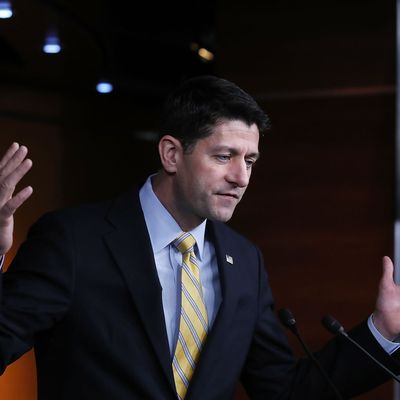
Paul Ryan has let the House GOP’s Obamacare-replacement bill out of the basement. On Monday night, Republicans introduced the American Health Care Act — a bill that, if passed, would repeal and replace president Obama’s signature achievement.
Here are the bill’s key features:
• The AHCA eliminates Obamacare’s controversial individual mandate. Instead of penalizing people for not having insurance, the AHCA encourages people to maintain continuous coverage by allowing insurers to increase their premiums by 30 percent if their coverage has lapsed. After a year, the premiums would go back to the standard rate.
This might actually discourage healthy people from buying insurance, driving up costs for everyone. A healthy person who lets their insurance lapse for more than 63 days has two options: 1) Buy insurance on the individual market immediately, and start paying premiums plus a 30 percent surcharge, or 2) remain uninsured while looking for a job that provides insurance, and pay nothing. Buy insurance and start paying the 30 percent surcharge if you happen to get sick.
• Obamacare’s income-based subsidies for people buying insurance through public exchanges would be replaced by tax credits tied to income and age. People under 30 would get a credit of $2,000 per year, gradually increasing to $4,000 for people over 60. To ensure that the credits aren’t available to wealthy Americans, they would drop off for individuals who make more than $75,000, or households that make more than $150,000. For every $1,000 earned over that mark, the credit would decrease by $100.
While it appears that older and poorer Americans are getting more help, as Vox notes, under the GOP plan insurers would be allowed to charge the oldest Americans five times as much as the youngest Americans. (Now they can only charge three times as much.) Poorer Americans could also see a decrease in their subsidies, while higher-earners would benefit from the new system:
This new tax credit structure could also hurt many low-income Americans, whose subsidies would fall substantially. The Kaiser Family Foundation estimates that these new tax credits would be anywhere between 31 and 82 percent lower for a 60-year-old who earns $20,000, depending on where that 60-year-old lives.
Higher-earning Americans, however, could see their benefits increase significantly. People who earned $48,280 or more under Obamacare got no help — but now anyone under the $75,000 threshold gets the biggest tax credit.
• The Medicaid expansion would continue — until 2020, when enrollment would “freeze,” and states would be barred from adding new low-income people to the rolls. Medicaid would also adopt per capita funding limits — meaning states would get a set allotment from the federal government for each enrollee. Currently, the federal government pays all of their bills.
• As of 2020, insurers would not be required to offer the “essential health benefits package” implemented under Obamacare. That means healthy people could buy cheaper, skimpier plans, but the cost of comprehensive plans would likely go up. The requirement that larger employers offer insurance to full-time employees would be axed.
• Obamacare’s taxes would remain in place until 2018. Drafts of the bill would have required people with high-cost employer-sponsored health insurance to pay income and payroll taxes, but that was dropped after employers and some Republicans framed it as a tax hike.
• Federal payments to Planned Parenthood through Medicaid and other government programs would be blocked for one year. People who receive tax credits to help pay for their premiums would not be allowed to buy plans to cover abortions.
• Insurers still won’t be able to discriminate against people with preexisting conditions, and children can stay on their parents’ plans until age 26.
Paul Ryan declared that the new plan will “deliver relief and peace of mind to the millions of Americans suffering under Obamacare.” But so far, no one else seems particularly excited about the AHCA.
Of course, Democrats were quick to criticize the plan, and they indicated that they have no intention of working with Republicans to pass it. “Trumpcare doesn’t replace the Affordable Care Act — it forces millions of Americans to pay more for less care,” said Senate Minority Leader Chuck Schumer.
But many Republican lawmakers attacked the bill for being insufficiently conservative. The House Freedom Caucus, which has about 40 members, voted last month to oppose any measure that falls short of the 2015 repeal bill. Representative Mark Meadows, chairman of the caucus, said Monday evening that at “first glance, we have concerns.” Freedom Caucus member and former chairman Jim Jordan said he didn’t see “any significant changes” from previous drafts. “My guess is this bill looks a lot like the last one, and we didn’t like the last one,” Jordan said.
Some Republicans may be challenging the legislation from the right, when their real issue is that they don’t want hundreds of thousands of constituents to lose their health-care coverage.
Four Senate Republicans — Rob Portman of Ohio, Shelley Moore Capito of West Virginia, Cory Gardner of Colorado, and Lisa Murkowski of Alaska — raised concerns that the Medicaid overhaul may hurt low-income Americans. “We are concerned that any poorly implemented or poorly timed change in the current funding structure in Medicaid could result in a reduction in access to life-saving health-care services,” they said.
Even if Republicans try to pass the measure through the budget reconciliation process — which requires only a simple majority — they can only afford to lose 2 votes in the Senate and 22 in the House.
While Republicans did not offer estimates of how much the plan will cost or how many people will lose their coverage, two House committees — Ways and Means, and Energy and Commerce — are set to take up the legislation on Wednesday. House Republicans hope that the full House will vote on the measure before a recess that begins April 7. The Senate timetable is unclear.
This post has been updated throughout.





























